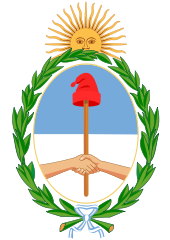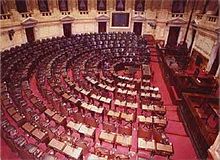- Argentine Chamber of Deputies
-
Argentine Chamber of Deputies
Honorable Cámara de Diputados de la Nación
Type Type Lower House Leadership President of the Chamber Eduardo Fellner,
PJ - FPV
since 10 Dec 20071st Vice-President of the Chamber Oscar Aguad,
UCR
since 10 Dec 2010Majority Leader Agustín Rossi,
PJ - FPV
since 10 Dec 2007Minority Leader Ricardo Gil Lavedra,
UCR
since 10 Dec 2010Members 257 (List) Political groups PJ - FPV
UCR
PJ Federal Peronism
CC-ARI
PRO
Civic Front for Santiago
Socialist Party
GEN
Proyecto Sur
New Encounter
MPN
Córdoba Civic Front
SI
PJ Federal Peronist Movement
Concertation Party
Federal Córdoba
Civic and Social Front of Catamarca
Free of the South Movement
PJ of La Pampa
Federal Consensus
FORJA
PJ of Jujuy
Salta Renewal Party
Democratic Party of Mendoza
Democratic Progressive Party
Dialogue for Buenos Aires
Federal Party of Tierra del Fuego
Liberal Party of Corrientes
We Are All Salta
Values for My Country
Front for Everyone
PJ Federal Peronist Front
[1]Elections Last election 28 June 2009 Meeting place 
Chamber of Deputies, Argentine Congress,
Buenos Aires, ArgentinaWebsite http://www.diputados.gov.ar The Chamber of Deputies is the lower house of the Argentine National Congress. This Chamber holds exclusive rights to create taxes, to draft troops, and to accuse the President, the ministers and the members of the Supreme Court before the Senate.
Contents
Composition
It has 257 seats and one-half of the members are elected every two years to serve four-year terms by the people of each district (23 Provinces and the Autonomous City of Buenos Aires) using proportional representation, D'Hondt formula with a 3% of the district registered voters threshold, and the following distribution:
- Buenos Aires Autonomous City: 25 deputies
- Buenos Aires Province: 70 deputies
- Catamarca Province: 5 deputies
- Chaco Province: 7 deputies
- Chubut Province: 5 deputies
- Córdoba Province: 18 deputies
- Corrientes Province: 7 deputies
- Entre Ríos Province: 9 deputies
- Formosa Province: 5 deputies
- Jujuy Province: 6 deputies
- La Pampa Province: 5 deputies
- La Rioja Province: 5 deputies
- Mendoza Province: 10 deputies
- Misiones Province: 7 deputies
- Neuquén Province: 5 deputies
- Río Negro Province: 5 deputies
- Salta Province: 7 deputies
- San Juan Province: 6 deputies
- San Luis Province: 5 deputies
- Santa Cruz Province: 5 deputies
- Santa Fe Province: 19 deputies
- Santiago del Estero Province: 7 deputies
- Tucumán Province: 9 deputies
- Tierra del Fuego Province: 5 deputies
History
The Chamber of Deputies was provided for in the Constitution of Argentina, ratified on May 1, 1853. Eligibility requisites are that members be at least twenty-five years old, and have been a resident of the province they represent for at least four years; as congressional seats are elected at-large, members nominally represent their province, rather than a district.[2]
Otherwise patterned after Article One of the United States Constitution per legal scholar Juan Bautista Alberdi's treatise, Bases de la Constitución Argentina, the chamber was originally apportioned in one seat per 33,000 inhabitants. The constitution made no provision for a national census, however, and because the Argentine population doubled every twenty years from 1870 to 1930 as a result of immigration (disproportionately benefiting Buenos Aires and the Pampas-area provinces), censuses were conducted generationally, rather than every decade, until 1947.[3]
Apportionment controversy
The distribution of the Chamber of Deputies is regulated since 1983 by Law 22.847, also called Ley Bignone, enacted by the last Argentine dictator, General Reynaldo Bignone, ahead of the 1983 general elections. This law establishes that, initially, each province shall have one deputy per 161,000 inhabitants, with standard rounding. After this is calculated, each province is granted three more deputies. If a province has fewer than five deputies, the number of deputies for that province is increased to reach that minimum.
Controversially, apportionment remains based on the 1980 population census, and has not been modified since 1983; national censuses since then have been conducted in 1991, 2001, and 2010. The minimum of five seat per province allots the smaller ones a disproportionately large representation, as well. Accordingly, this distribution does not reflect Argentina's current population balance.
Presidents of the Chamber
The President of the Chamber is elected by the majority caucus. The officeholders for this post since 1983 have been:
Term began Term ended Officeholder Party Province December 10, 1983 April 3, 1989 Juan Carlos Pugliese UCR  Buenos Aires Province
Buenos Aires ProvinceApril 3, 1989 July 8, 1989 Leopoldo Moreau UCR  Buenos Aires Province
Buenos Aires ProvinceJuly 8, 1989 December 10, 1999 Alberto Pierri PJ  Buenos Aires Province
Buenos Aires ProvinceDecember 10, 1999 December 10, 2001 Rafael Pascual UCR  City of Buenos Aires
City of Buenos AiresDecember 10, 2001 December 10, 2005 Eduardo Camaño PJ  Buenos Aires Province
Buenos Aires ProvinceDecember 10, 2005 December 10, 2007 Alberto Balestrini PJ  Buenos Aires Province
Buenos Aires ProvinceDecember 10, 2007 to date Eduardo Fellner FPV - PJ  Jujuy
JujuyCurrent authorities
Leadership positions include:
Title Officeholder Party Province Chamber President Eduardo Fellner FPV  Jujuy
JujuyFirst Vice-President Oscar Aguad UCR  Córdoba
CórdobaSecond Vice-President Patricia Fadel FPV  Mendoza
MendozaThird Vice-President Ramón Puerta Federal Peronism  Misiones
MisionesParliamentary Secretary Enrique Hidalgo Administrative Secretary Ricardo Vázquez Coordinating Secretary Jorge Ocampos Composition by Party blocks
Further information: List_of_current_Argentine_deputies#Party alignments (as of June 2011)Chamber of Deputies of Argentina*
(as of March 10, 2010)Party blocs* Seats Party blocs Seats PJ - Front for Victory (FPV) 87 Radical Civic Union (UCR) 43 PJ Federal Peronism 28 Civic Coalition (CC-ARI) 19 Republican Proposal (PRO) 11 Civic Front for Santiago 7 Socialist Party 6 New Popular and Social Encounter 5 Generation for a National Encounter 5 Proyecto Sur 5 Peronist 4 Neuquino People's Movement (MPN) 3 Córdoba Civic Front 3 Solidarity and Equality (SI) 3 PJ Peronist Unity Nucleus 3 Concertation 2 Federal Córdoba 2 PJ of La Pampa 2 Free of the South Movement 2 Current of Federal Thought 2 Dialogue for Buenos Aires 1 Civic and Social Front of Catamarca 1 Federal Consensus 1 Federal Party of Tierra del Fuego 1 FORJA 1 PJ of Jujuy 1 Salta Renewal Party 1 Democratic Party of Mendoza 1 Democratic Progressive Party 1 Patagonia Social Party 1 Front for Everyone 1 Liberal Party of Corrientes 1 We Are All Salta 1 PJ Federal Peronist Front 1 Values for My Country 1 257 members 2009 election
See List of current Argentine Deputies and Argentine legislative election, 2009
Argentine Chamber of Deputies: Composition, 2009-2011 Political Party
Seats Net
Change
in seats% of
VotesCaucus leader Front for Victory 87 -20 26.7 Agustín Rossi Radical Civic Union 43 +14 9.0 Oscar Aguad Federal Peronism 29 +25 8.7 Felipe Solá Civic Coalition 19 +4 18.1 Elisa Carrió Republican Proposal 11 +3 18.5 Federico Pinedo Civic Front for Santiago (allied with Front for Victory) 7 +1 1.0 Daniel Brue Socialist Party 6 -4 0.8 Mónica Fein Peronist Party 6 -2 0.7 ~ New Popular and Solidary Encounter 5 +5 2.1 Martín Sabbatella Generation for a National Encounter 5 +3 2.0 Margarita Stolbizer Project South 4 +3 2.3 Fernando Solanas Córdoba Civic Front (allied with Civic Coalition) 3 +3 2.4 Ernesto Martínez Neuquén People's Movement 3 0 0.4 Alicia Comelli Solidarity and Equality 3 -4 0.5 Eduardo Macaluse Others (21 parties) 26 -31 6.8 Total 254 2007 election
See Argentine general election, 2007
References
External links
Categories:- National lower houses
- Government of Argentina
- Members of the Argentine Chamber of Deputies
- Argentine National Congress
Wikimedia Foundation. 2010.
